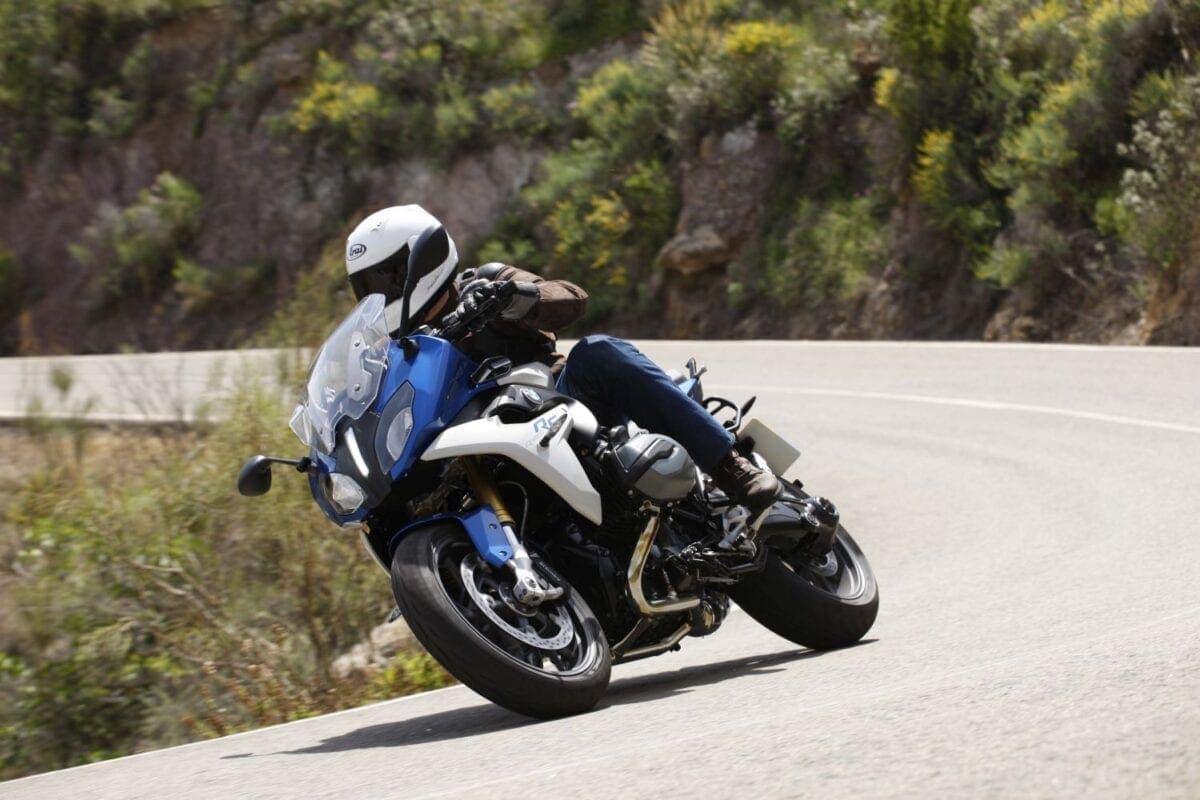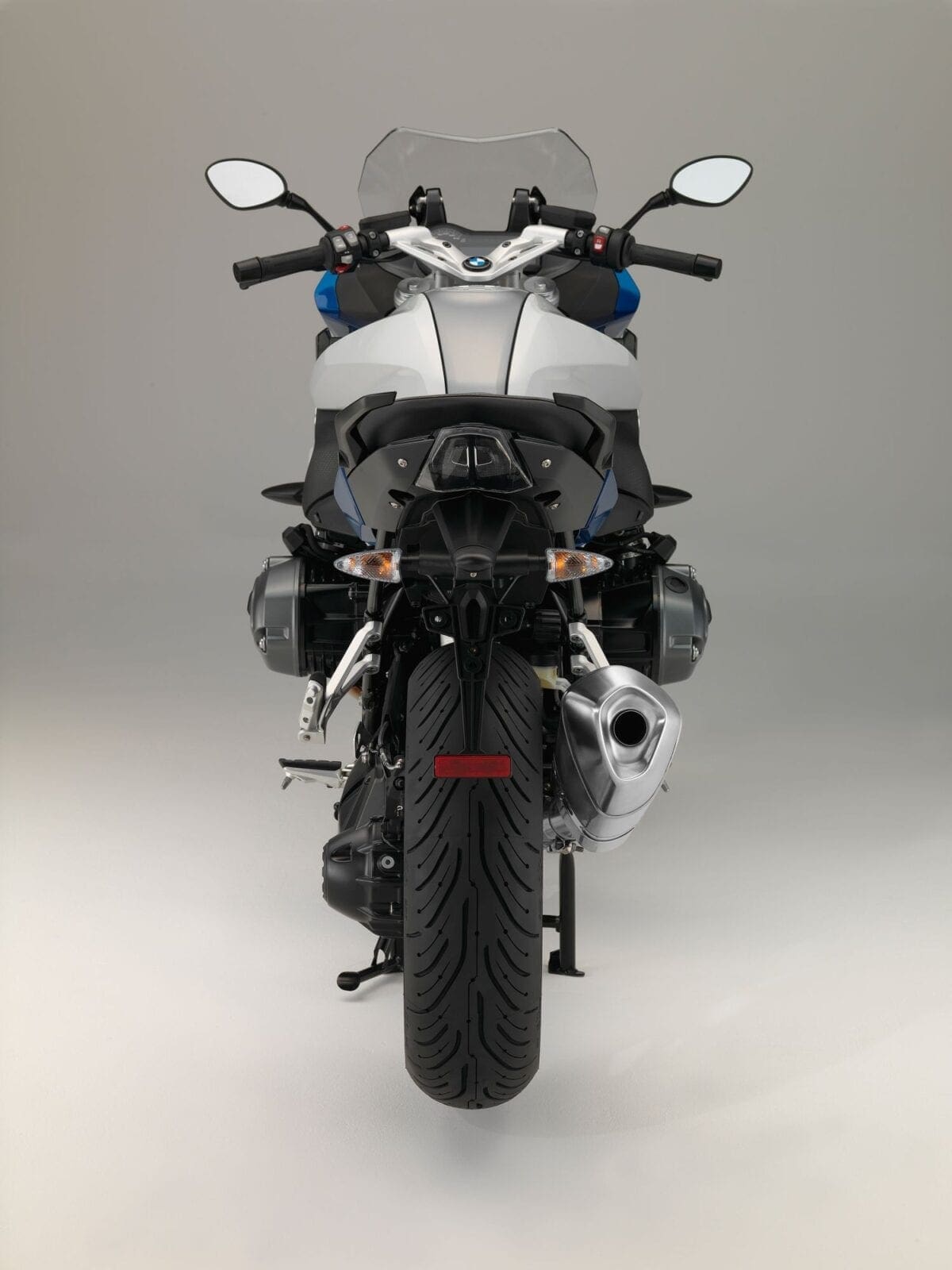Tested by: John Milbank Pictures by: James Wright and Jason Critchell
BMW’s R1200RS is much more than a tweak to the model with a fairing bolted on. True, the motor is the same water-cooled boxer twin used in the R1200GS and R1200RT, producing 123bhp at 7750 rpm and 92lb-ft at 6500rpm, but if you’ve ridden one of these engines before then you’ll know just how useful and enjoyable that lump really is. The airbox, intakes and radiator have been modified for the RS (and R) to suit the new bike’s design; BMW says this has a slight benefit to low-down torque. The motor pulls cleanly from just 2500rpm, with a healthy 74lb-ft of torque from the off – that’s only 9lb-ft less than the S1000RR’s peak.
The machine’s strong, and it’s capable of going very fast, but it doesn’t have that frantic feel to it of many motorcycles. At about 4000rpm the engine softens off a touch, but this is the only noticeable lull in the smooth delivery – as the single-colour Thin Film Transistor (TFT) display reaches 5000rpm, you’re pushed ever harder forwards, without fear of a sudden rush of unwanted acceleration.
On the face of it, with the R and RS basically the same machine from the headstock back, the £600-£1000 premium the faired bike commands might leave you wondering which to choose. Both have the same ride height, but by altering the design of the fork-bottoms for the RS, the front wheel has been moved forward, reducing castor and increasing the wheelbase by 15mm. This is to give the RS a slightly slower feel to the steering – not that the R is twitchy, but the focus is moving away from a street machine to a sports-tourer.
Compared to a machine like Kawasaki’s Z1000SX, the RS has an 85mm longer wheelbase – you’re aware of this being the larger bike in corners, but that fits well with the more mild-mannered power delivery and riding position of the BMW, and it still responds quickly.
The test ride was blighted by very high winds – rounding a mountain corner early on I was hit by a gust that didn’t unsettle the bike, but did make it feel like it wanted to drop quickly into a corner. Fortunately, we had the chance of three relatively sedate laps of the Almeria race circuit, which proved how stable and predictable the bike really is. Later routes saw perilously exposed narrow roads, with no barriers to protect us from the sharp drops, but the RS’s composure and manners (and my refusal to look down) made it a safe and enjoyable ride.
The BMW has two riding modes as standard – Road and Rain; the other journalists laughed, but I preferred Rain mode whilst navigating the hairpins up and down the mountains; by subtly reducing the throttle response when rolling on and off the power, it made for a much smoother and easier ride. As the route opened up, Road mode gave a more instant delivery of power.
Riding Mode Pro offers a sharper-still Dynamic option, and also a User mode, which allows the rider to set their own parameters – a more enticing option for me.
Our bikes were fitted with Gear Assist Pro. I thought a quick-shifter might be something of a gimmick at first – would a road-rider really need to eak out every last millisecond during gear changes, especially with a ’box so smooth and faultless? When accelerating hard, the ease of changing up without using the clutch or having to roll off is good, but it’s in downshifts that it really shines. As you slow into a tight bend, knock down the lever and the engine double-declutches, giving a perfectly timed bark as the system revs the motor to perfectly match the input and output shaft speeds. It’s a clever piece of tech, and if it’s part of the package you buy, you certainly won’t begrudge it.
The ABS is unintrusive, and when it does work, it feels well balanced. I misjudged a corner riding a dusty road on the plains; while I could feel the system sorting things out, it was subtle and well handled.
The RS is a comfortable all-rounder; I realised at the first coffee break after about 60 miles that I was completely unaware of the riding position. Despite it being rather a stop-start journey, I usually suffer a numb-bum pretty quickly. Not on the plush BMW, which also has a perfectly comfortable peg position. It just works; it was easy for me, at 5’11”, to get both feet on the ground, the 820mm seat inspiring confidence when turning around in gravelly lay-bys. Shorter riders found the same thing, and the option of 790mm or 760mm seats (or 840mm for the 6’7” journalist present) made it easy to get the perfect set up.
Like the R1200R, the RS shuns BMW’s Telelever front-end for more common 45mm upside-down forks. The rear is a Paralever single-sided swingarm with single shock and a long-distance friendly shaft-drive, while the tubular steel bridge frame was designed specifically for the R and RS.
There are no knobs or levers needed to adjust the screen, but there is a bit of a knack when you get up to cruising speed. Simply pulling up the scratch-resistant windshield puts it in the higher position, or push it down to drop it. It works on an off-centre lever mechanism, so drops securely into place, but at 70mph it can be a bit reluctant to move. The screen can also be unbolted and fixed in an inch-lower position on the mechanism, effectively giving four different settings. I found the buffeting noise around my Arai Quantum ST a little distracting with the screen up, so preferred to drop it down – I’d consider a taller option screen if I was doing any major touring.
I found the large speedo and TFT display easy to read even in bright sunlight. A built-in light sensor adjusts screen brightness for the conditions, and also switches between day and night modes. There’s a lot of information on offer, but you can cycle between three styles. I preferred the ‘sport’ layout, as it simplified the display while still offering an engine speed graph. Taller riders though – such as 6’4” Roland Brown – found it difficult to read the bottom of the screen as the handlebar assembly was reflected in the unit.
You’d have no trouble touring on an R1200R, but the RS is the sensible, more mature brother. The pillion seat is thick and comfortable (a thinner one is available as an option), with the rear grab rails offering plenty to hang on to. It’ll carry the same luggage as the R, but that extra weather protection makes it the one I’d choose for any serious miles. My only caveat to that would be the 18 litre tank. When I got on the bike, the previous miles had achieved 44mpg; the stop-start nature, and hard acceleration of a bike launch always reduces economy, so I saw 38mpg over the 160-odd mile journey. Realistically then, a more average ride will be likely to see a range of about 180 miles – if a greater capacity would have meant a less comfortable and practical riding position, then once again, BMW has made the most sensible decisions.
Specification: BMW R1200R
Engine: 1170cc, air/liquid-cooled boxer twin
Peak power: 125bhp @ 7750rpm
Peak torque: 92lb-ft @ 6500rpm
Transmission: 6 speed
Final drive: Cardan shaft
Frame: Tubular steel bridge frame
Wheelbase: 1530mm
Tyres:
Front – 120/70/17
Rear – 180/55/17
Weight (wet): 236kg
Seat height: 820mm
Fuel capacity: 18 litres
Contact: www.bmw-motorrad.co.uk







